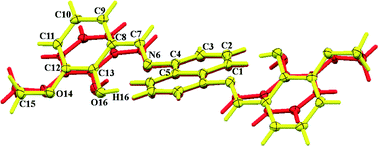Polymorphism driven optical properties of an anil dye†
Abstract
Red crystals of N,N′-bis(3-methoxysalicylidene)-1,5-diiminonaphthalene were obtained after Schiff base condensation in ethanol. Recrystallization from acetone afforded yellow crystals, a process which is reversible and reproducible. Single crystal X-ray diffraction evidences two polymorphs differing in their space group and dihedral angle between aromatic moieties. DFT periodic calculations further confirmed the existence of two minima on the potential energy surface corresponding to red and yellow crystals. The red polymorph irreversibly (monotropically) transforms at 165–190 °C into the yellow one with a 3% increase of the unit cell volume, as shown by X-ray powder diffraction and periodic DFT calculations. Both polymorphs are thermochromic but only the red one displays photochromism upon irradiation at λ = 365 nm, which is reversible and exhibits a relatively slow thermal relaxation. A temperature induced cis/trans-keto equilibrium is for the first time identified for an N-salicylidene aniline derivative. Static DFT molecular and periodic calculations as well as ab initio Born–Oppenheimer dynamics simulations were performed to characterize the stability of both polymorphs and to determine the relative populations of the enol/cis-keto/trans-keto isomers at various temperatures.

- This article is part of the themed collection: Solid-State Photochemistry


 Please wait while we load your content...
Please wait while we load your content...